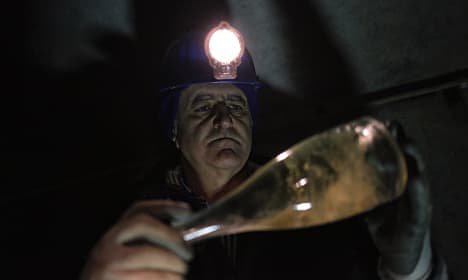Meet the Italian making wine underground

He made his career in the quarrying
business, but Mauro Camusso always had wine in his blood.
Now he has brought the two strands together in the production of a champagne-style sparkling wine that he finishes deep in the bowels of a disused mineral mine.
Located in the foothills of the Italian Alps, some 50 kilometres (30 miles) southwest of Turin, the Val Germanasca mine produced talc, the material used to make talcum powder, up until the mid-1990s.
And now it has found a new role thanks to Camusso deciding to pick up where his winemaker grandfather left off and get into the business.
Camusso, owner of an estate called L'Autin (little vine in local dialect), only planted his first grapes - including parcels of Chardonnay and Pinot Noir - in 2010 and made his first wines from grapes harvested in 2013.
In 2015, for the first time, he sent 3,000 bottles of would-be fizz down the mine to undergo the critical stage in their production, the secondary fermentation, deep underground.
That involves adding yeasts and sugar to a base still white wine to trigger the reaction that creates the crucial bubbles, in line with a method pioneered in Champagne and used for most of the world's prestigious sparklers.
Opened in 1937, the mine's tunnels were too small for modern machinery and it closed in 1995, reopening two years later as a museum of its past activity.
"The conditions in the talc mine are very particular," Camusso said.
New lease of life
"There's a constant temperature of 10 degrees (Celsius, 50 degrees Fahrenheit) all year round. It is dark and the humidity is nearly 90 percent.
In theory the conditions are perfect for making bubbles!"
The bottles are stocked horizontally for between 10 and 12 months and turned delicately from time to time to create as fine a fizz as possible.
They then spend around three weeks suspended upside down so the residue of the yeasts settles in the neck of the bottle.
And just like real miners, Mauro and his workers have to wear headlamps to get the job done.
Andrea Peyrot, one of Camusso's workers, says the venture has given the former industrial site a new lease of life in the 21st century.
"If the mines are not looked after they close themselves naturally," he told AFP. "So making this wine here is also a way of keeping the mining tradition alive in the region."
Camusso has been encouraged by early samples.
"The quality seems to be good," he says.
But it will be a few years yet before he knows if the unusual cellar conditions "bring a little something extra" to his underground wine.
Comments
See Also
Now he has brought the two strands together in the production of a champagne-style sparkling wine that he finishes deep in the bowels of a disused mineral mine.
Located in the foothills of the Italian Alps, some 50 kilometres (30 miles) southwest of Turin, the Val Germanasca mine produced talc, the material used to make talcum powder, up until the mid-1990s.
And now it has found a new role thanks to Camusso deciding to pick up where his winemaker grandfather left off and get into the business.
Camusso, owner of an estate called L'Autin (little vine in local dialect), only planted his first grapes - including parcels of Chardonnay and Pinot Noir - in 2010 and made his first wines from grapes harvested in 2013.
In 2015, for the first time, he sent 3,000 bottles of would-be fizz down the mine to undergo the critical stage in their production, the secondary fermentation, deep underground.
That involves adding yeasts and sugar to a base still white wine to trigger the reaction that creates the crucial bubbles, in line with a method pioneered in Champagne and used for most of the world's prestigious sparklers.
Opened in 1937, the mine's tunnels were too small for modern machinery and it closed in 1995, reopening two years later as a museum of its past activity.
"The conditions in the talc mine are very particular," Camusso said.
New lease of life
"There's a constant temperature of 10 degrees (Celsius, 50 degrees Fahrenheit) all year round. It is dark and the humidity is nearly 90 percent.
In theory the conditions are perfect for making bubbles!"
The bottles are stocked horizontally for between 10 and 12 months and turned delicately from time to time to create as fine a fizz as possible.
They then spend around three weeks suspended upside down so the residue of the yeasts settles in the neck of the bottle.
And just like real miners, Mauro and his workers have to wear headlamps to get the job done.
Andrea Peyrot, one of Camusso's workers, says the venture has given the former industrial site a new lease of life in the 21st century.
"If the mines are not looked after they close themselves naturally," he told AFP. "So making this wine here is also a way of keeping the mining tradition alive in the region."
Camusso has been encouraged by early samples.
"The quality seems to be good," he says.
But it will be a few years yet before he knows if the unusual cellar conditions "bring a little something extra" to his underground wine.
Join the conversation in our comments section below. Share your own views and experience and if you have a question or suggestion for our journalists then email us at [email protected].
Please keep comments civil, constructive and on topic – and make sure to read our terms of use before getting involved.
Please log in here to leave a comment.